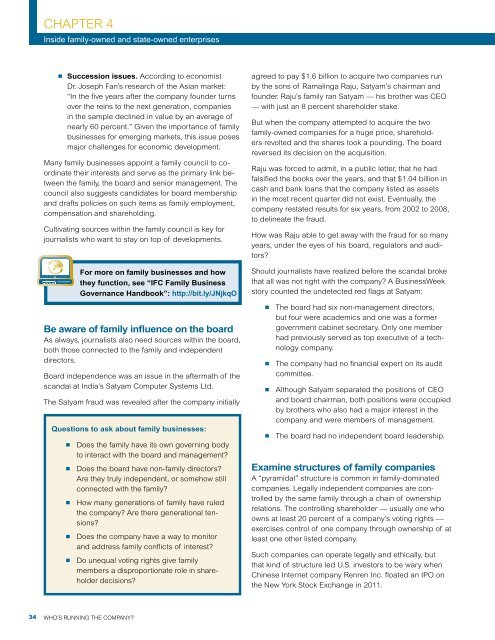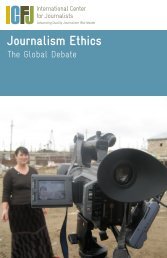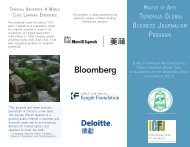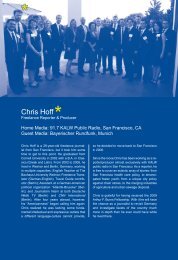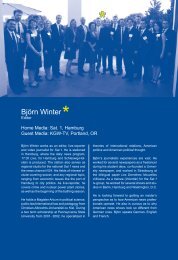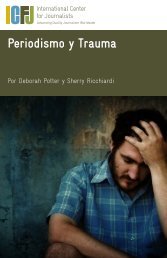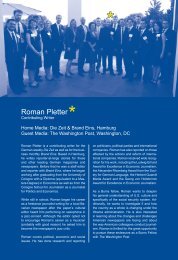Who's Running the Company? - International Center for Journalists
Who's Running the Company? - International Center for Journalists
Who's Running the Company? - International Center for Journalists
You also want an ePaper? Increase the reach of your titles
YUMPU automatically turns print PDFs into web optimized ePapers that Google loves.
CHAPTER 4<br />
Inside family-owned and state-owned enterprises<br />
n Succession issues. According to economist<br />
Dr. Joseph Fan’s research of <strong>the</strong> Asian market:<br />
“In <strong>the</strong> five years after <strong>the</strong> company founder turns<br />
over <strong>the</strong> reins to <strong>the</strong> next generation, companies<br />
in <strong>the</strong> sample declined in value by an average of<br />
nearly 60 percent.” Given <strong>the</strong> importance of family<br />
businesses <strong>for</strong> emerging markets, this issue poses<br />
major challenges <strong>for</strong> economic development.<br />
Many family businesses appoint a family council to coordinate<br />
<strong>the</strong>ir interests and serve as <strong>the</strong> primary link between<br />
<strong>the</strong> family, <strong>the</strong> board and senior management. The<br />
council also suggests candidates <strong>for</strong> board membership<br />
and drafts policies on such items as family employment,<br />
compensation and shareholding.<br />
Cultivating sources within <strong>the</strong> family council is key <strong>for</strong><br />
journalists who want to stay on top of developments.<br />
For more on family businesses and how<br />
<strong>the</strong>y function, see “IFC Family Business<br />
Governance Handbook”: http://bit.ly/JNjkqO<br />
Be aware of family influence on <strong>the</strong> board<br />
As always, journalists also need sources within <strong>the</strong> board,<br />
both those connected to <strong>the</strong> family and independent<br />
directors.<br />
Board independence was an issue in <strong>the</strong> aftermath of <strong>the</strong><br />
scandal at India’s Satyam Computer Systems Ltd.<br />
The Satyam fraud was revealed after <strong>the</strong> company initially<br />
Questions to ask about family businesses:<br />
n Does <strong>the</strong> family have its own governing body<br />
to interact with <strong>the</strong> board and management?<br />
n Does <strong>the</strong> board have non-family directors?<br />
Are <strong>the</strong>y truly independent, or somehow still<br />
connected with <strong>the</strong> family?<br />
n How many generations of family have ruled<br />
<strong>the</strong> company? Are <strong>the</strong>re generational tensions?<br />
n Does <strong>the</strong> company have a way to monitor<br />
and address family conflicts of interest?<br />
n Do unequal voting rights give family<br />
members a disproportionate role in shareholder<br />
decisions?<br />
agreed to pay $1.6 billion to acquire two companies run<br />
by <strong>the</strong> sons of Ramalinga Raju, Satyam’s chairman and<br />
founder. Raju’s family ran Satyam — his bro<strong>the</strong>r was CEO<br />
— with just an 8 percent shareholder stake.<br />
But when <strong>the</strong> company attempted to acquire <strong>the</strong> two<br />
family-owned companies <strong>for</strong> a huge price, shareholders<br />
revolted and <strong>the</strong> shares took a pounding. The board<br />
reversed its decision on <strong>the</strong> acquisition.<br />
Raju was <strong>for</strong>ced to admit, in a public letter, that he had<br />
falsified <strong>the</strong> books over <strong>the</strong> years, and that $1.04 billion in<br />
cash and bank loans that <strong>the</strong> company listed as assets<br />
in <strong>the</strong> most recent quarter did not exist. Eventually, <strong>the</strong><br />
company restated results <strong>for</strong> six years, from 2002 to 2008,<br />
to delineate <strong>the</strong> fraud.<br />
How was Raju able to get away with <strong>the</strong> fraud <strong>for</strong> so many<br />
years, under <strong>the</strong> eyes of his board, regulators and auditors?<br />
Should journalists have realized be<strong>for</strong>e <strong>the</strong> scandal broke<br />
that all was not right with <strong>the</strong> company? A BusinessWeek<br />
story counted <strong>the</strong> undetected red flags at Satyam:<br />
n The board had six non-management directors,<br />
but four were academics and one was a <strong>for</strong>mer<br />
government cabinet secretary. Only one member<br />
had previously served as top executive of a technology<br />
company.<br />
n The company had no financial expert on its audit<br />
committee.<br />
n Although Satyam separated <strong>the</strong> positions of CEO<br />
and board chairman, both positions were occupied<br />
by bro<strong>the</strong>rs who also had a major interest in <strong>the</strong><br />
company and were members of management.<br />
n The board had no independent board leadership.<br />
Examine structures of family companies<br />
A “pyramidal” structure is common in family-dominated<br />
companies. Legally independent companies are controlled<br />
by <strong>the</strong> same family through a chain of ownership<br />
relations. The controlling shareholder — usually one who<br />
owns at least 20 percent of a company’s voting rights —<br />
exercises control of one company through ownership of at<br />
least one o<strong>the</strong>r listed company.<br />
Such companies can operate legally and ethically, but<br />
that kind of structure led U.S. investors to be wary when<br />
Chinese Internet company Renren Inc. floated an IPO on<br />
<strong>the</strong> New York Stock Exchange in 2011.<br />
34<br />
WHO’S RUNNING THE COMPANY?


